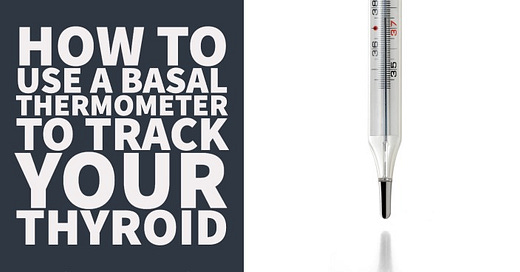FAQ Episode 30b: Checking Basal Body Temperatures to assess the Thyroid/Migraine connection
Frequently Asked Questions about Natural Migraine Relief for Women
This segment is a follow up companion piece to FAQ Episode 30: Low Thyroid and Migraines
The body heat produced in the resting or basal state is a reflection of the cumulative energy produced by the trillions of cells in your body. If the “metabolic sparkplugs” provided by your thyroid hormones are at a lower than optimal level, this “basal body temperature” (BBT) indicator may dip.
Resting body temperature can also be affected by multiple factors I’ve listed below. It also may be lower than average for those who have lost muscle mass or muscle fitness over time. But apart from these factors, tracking your basal body temperature along with standard thyroid blood tests may be helpful in evaluating and monitoring functional thyroid status.
Typically, a resting under-arm temperature reading of 96 to 98 degrees Fahrenheit (35.5 to 36.6 Celsius) is typical before ovulation in women. With ovulation, a women’s BBT can rise to roughly 1 degree for the 24-48 hours. BBT as a reflection of thyroid metabolism should exclude the temps for the day before, during and after ovulation.
There is no specific temperature cutoff to suspect a hypothyroid state, but I’ve found that individuals with suboptimal thyroid often run 1-2 degrees under normal temperature ranges. It can be an useful home indicator suggesting that further and more complete blood testing for a low thyroid state is indicated. It can also help confirm if supplemental thyroid is correcting a suboptimal metabolism. I don’t believe that a BBT can or should serve as your only thyroid sufficiency indicator.
How to measure your basal body temperature
To measure your basal body temperature, use a thermometer that can measure up to 2 decimal places (like ’96.25’.) You can purchase these at any pharmacy or drugstore or easily find them online. The inexpensive “beeps when its done” versions usually work fine for this.
Here are four things to keep in mind to effectively monitor your basal temperature:
Take your temperature first thing you wake up, while you’re still in bed. Most doctors recommend placing the thermometer in the armpit for five minutes (or until the sensor notifies you) before reading it. Have the thermometer close at hand to your bedstand to limit activity around taking the reading.
In a journal where you track the BBTs, also note any factors on each day that could influence your BBT, including:
ovulation status
use of alcohol, intake of a heavy meal or heavy exercise the night before
a recent medication change
greater than average stress
potential infections, like a cold or flu
traveling between different time zones
3. Check the temperatures for 4-5 days to find a baseline. If having monthly cycles, Days 2-3 through 6-8 are usually the most consistent temps of the menstrual month.
Track your temperatures in your notes and check with your doctor if you notice consistently low temperatures such as less than 96 degrees.
In conclusion, the evaluation of your BBT can add to detailed symptom evaluation and appropriate blood testing to assess your functional thyroid levels.
If you correct a low thyroid level, the potential benefits including the clearing of migraines can be life changing.




